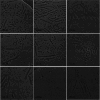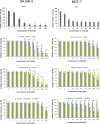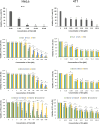Comparison of Micelles Single- and Dual-Targeted with Folic Acid and Biotin as the Delivery System of Docetaxel─The Influence of the Type and Amount of the Ligand on Morphology, Physicochemical Properties, and Cytotoxicity
- PMID: 40566834
- PMCID: PMC12326352
- DOI: 10.1021/acs.molpharmaceut.5c00215
Comparison of Micelles Single- and Dual-Targeted with Folic Acid and Biotin as the Delivery System of Docetaxel─The Influence of the Type and Amount of the Ligand on Morphology, Physicochemical Properties, and Cytotoxicity
Abstract
Nanoparticles (NPs) dual-targeted with folic acid (FA) and biotin (BIO) are developed to overcome problems associated with conventional chemotherapy and tumor heterogeneity. Although some preliminary studies have been conducted to develop dual-targeted micelles for delivery of docetaxel (Dtx), a more detailed analysis is needed to discover their pharmaceutical potential. Therefore, this manuscript is focused on a comprehensive analysis of the influence of the type and density of targeting ligand on micelles' morphology, physicochemical properties, drug loading and release, cell internalization, cytotoxicity in vitro against several kinds of cells and in vivo on two mice cancer models. For this purpose, three kinds of micelles were obtained: decorated with one type of ligand (FA or BIO) and dual-targeted. The micelles contained different amounts of FA- and/or BIO-functionalized polymer (10, 25, and 50%). Additionally, the dual-targeted micelles were compared with a mixture of two kinds of single-targeted micelles. The study showed that the cytotoxic effect of micelles strongly depends on the type of cancer cells and their surface characteristics. The micelles with a higher density of ligands may have higher efficiency against cells with lower expression of cell surface receptors (SK-BR-3 and MCF-7). Conversely, micelles with lower ligand density may be advantageous against cancer cells with overexpression of surface receptors (HeLa, 4T1). Interestingly, the drug delivered in FA-targeted micelles showed higher cytotoxicity compared to dual-targeted micelles in which two ligands are present on the same NP. However, Dtx delivered in a mixture of micelles single-targeted with FA and BIO showed the highest cytotoxic effect, which was confirmed in vitro and in vivo on the mice model.
Keywords: PLA−PEG; active targeting; biotin; docetaxel; dual-targeted micelles; folic acid; nanoparticles.
Figures










Similar articles
-
The effect of Fe3O4 biosynthesized through the green synthesis of Silybum marianum and HA in the targeted delivery of 5-Fluorouracil to HCT116 cell line.Daru. 2025 Jul 31;33(2):27. doi: 10.1007/s40199-025-00568-9. Daru. 2025. PMID: 40742481
-
A rapid and systematic review of the clinical effectiveness and cost-effectiveness of paclitaxel, docetaxel, gemcitabine and vinorelbine in non-small-cell lung cancer.Health Technol Assess. 2001;5(32):1-195. doi: 10.3310/hta5320. Health Technol Assess. 2001. PMID: 12065068
-
Preparation and evaluation of Baicalin-loaded albumin nanoparticles for anti-breast cancer activity.Int J Biol Macromol. 2025 Jul;318(Pt 1):144799. doi: 10.1016/j.ijbiomac.2025.144799. Epub 2025 Jun 1. Int J Biol Macromol. 2025. PMID: 40460958
-
Formation and evaluation of docetaxel and triptolide polymer micelles for anti-cancer activity.Nanomedicine (Lond). 2025 Aug;20(16):1999-2011. doi: 10.1080/17435889.2025.2535281. Epub 2025 Jul 30. Nanomedicine (Lond). 2025. PMID: 40736067
-
Systemic treatments for metastatic cutaneous melanoma.Cochrane Database Syst Rev. 2018 Feb 6;2(2):CD011123. doi: 10.1002/14651858.CD011123.pub2. Cochrane Database Syst Rev. 2018. PMID: 29405038 Free PMC article.
References
-
- Imran M., Saleem S., Chaudhuri A., Ali J., Baboota S.. Docetaxel: An update on its molecular mechanisms, therapeutic trajectory and nanotechnology in the treatment of breast, lung and prostate cancer. J. Drug Delivery Sci. Technol. 2020;60:101959. doi: 10.1016/j.jddst.2020.101959. - DOI
-
- Glatt D. M., Beckford Vera D. R., Prabhu S. S., Mumper R. J., Luft J. C., Benhabbour S. R., Parrott M. C.. Synthesis and Characterization of Cetuximab–Docetaxel and Panitumumab–Docetaxel Antibody–Drug Conjugates for EGFR-Overexpressing Cancer Therapy. Mol. Pharmaceutics. 2018;15(11):5089–5102. doi: 10.1021/acs.molpharmaceut.8b00672. - DOI - PubMed
-
- Sousa-Pimenta M., Estevinho L. M., Szopa A., Basit M., Khan K., Armaghan M., Ibrayeva M., Sönmez Gürer E., Calina D., Hano C., Sharifi-Rad J.. Chemotherapeutic properties and side-effects associated with the clinical practice of terpene alkaloids: paclitaxel, docetaxel, and cabazitaxel. Front. Pharmacol. 2023;14:1157306. doi: 10.3389/fphar.2023.1157306. - DOI - PMC - PubMed
Publication types
MeSH terms
Substances
LinkOut - more resources
Full Text Sources
Medical
Miscellaneous

